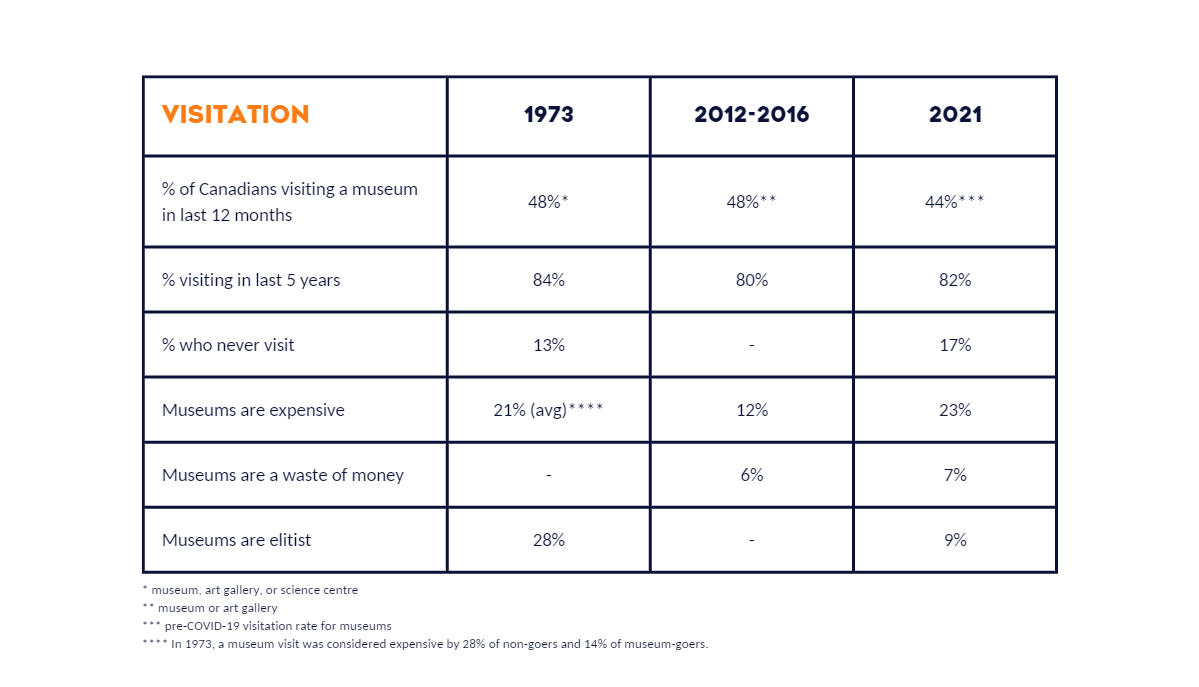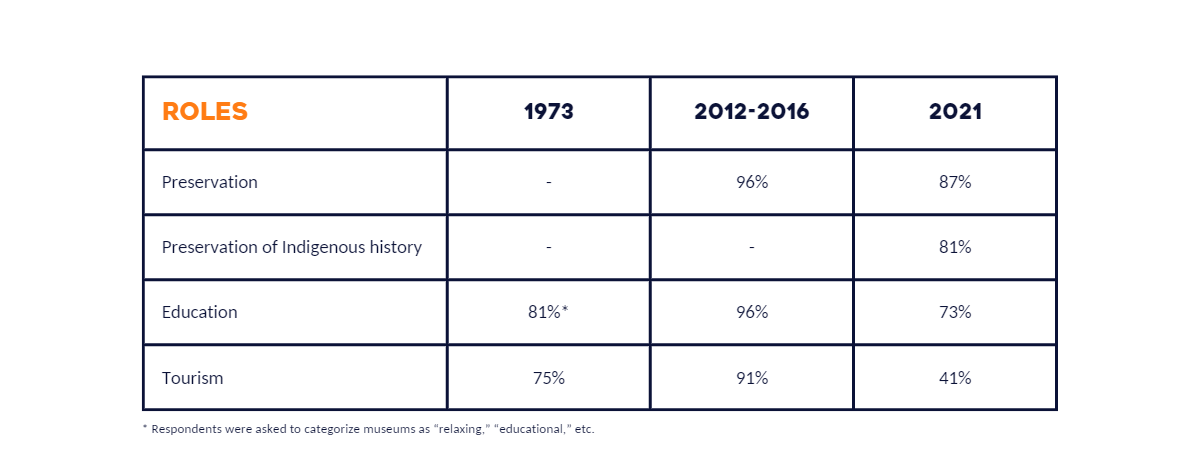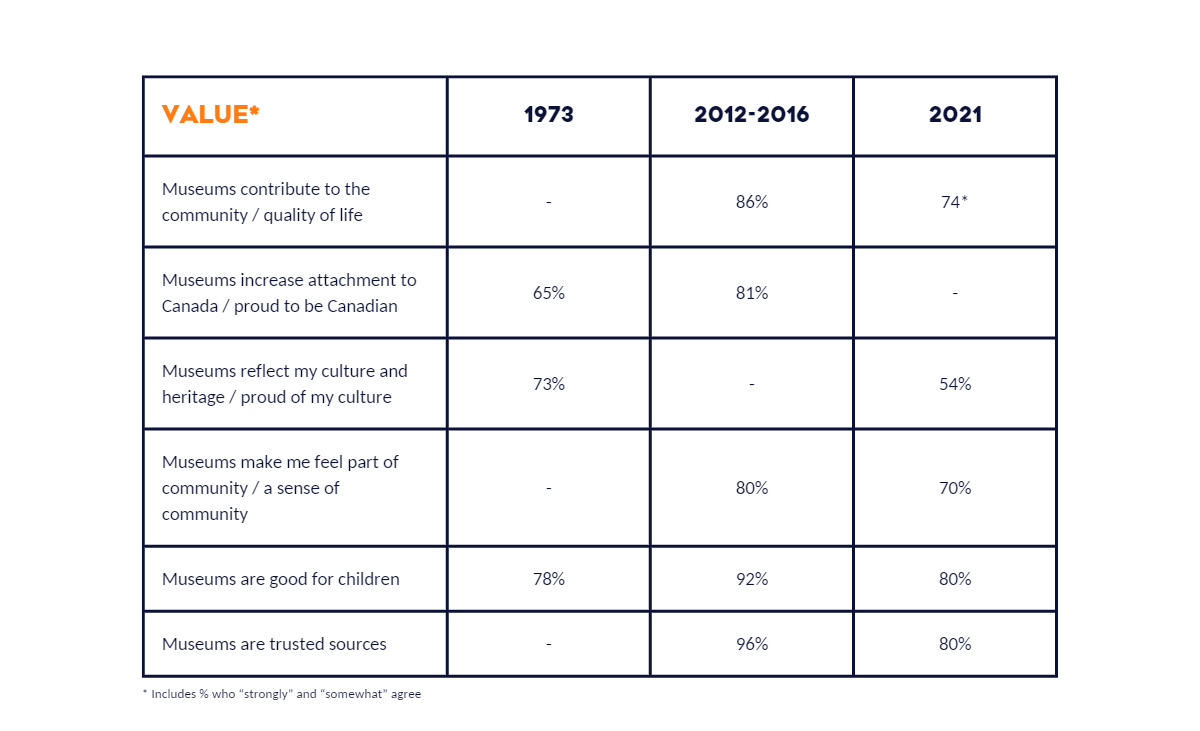Reconsidering Museums is the first time since 1973 that a national
study gathered data on the Canadian public’s perceptions and attitudes. The
1973 study titled, The Museum and the Canadian Public by Brian Dixon, Alice
Courtney, and Robert Bailey, was conducted in conjunction Canada’s first National
Museum Policy, released the previous year.
To understand changes in public perception between Museums For Me in 2021 and the 1973 study, three questions were considered:
- What has stayed the same?
- What has changed?
- What will change?
These questions are explored in more detail in the Trust and Value report
by Dr. Victoria Dickenson.
In 1972, there were 838 museums in Canada, as of 2016 this number
has more than tripled to over 2600 museums in Canada. There has been a change
in public perception and attitudes toward museums since 1973 that reflects the
increasing number of museums for Canadians to visit, an increase in museums’
public programming, as well as societal changes.
The tables below illustrate the key changes. The data sources for
the following tables is as follows: 1973 data is from Dixon et al, Museum and
the Canadian Public; 2012 – 2016 data is from Statistics Canada GSS surveys;
and 2021 data from is Museums For Me Leger Opinion online panel conducted for
H+K.
Museum Visitation
The percentage of Canadians visiting museums has not changed significantly between the two studies, but there is an increase in the perception that museums are expensive as of 2021. However, the percentage of Canadians who see museums as elitist has decreased significantly since 1973. Today, the vast majority of Canadians do not consider museums to be elitist.
For more information on visitation data, see the Who is Visiting Canada’s Museums?: Demographics and Visitation and Exploring Financial Accessibility: Cost as a Potential Barrier to Visitation data stories.

The Role of the Museum
Today museums are not just places for tourists. Education as a primary role is declining slightly in importance since 1973, while the preservation of Indigenous knowledge and collections is increasingly a more important role for the museum.

The Value of Museums
Canadians still consider museums to be trusted sources and good places for children. However, there was a decrease in the percentage of Canadians who found museums to reflect their culture and heritage today, likely due to Canada’s increasingly growing and diverse population.

What does this mean for the future of museums?
Canada’s population is becoming increasingly diverse based on these projections from Statistics Canada:
- By 2036, immigrants and second-generation individuals will represent between 40% and 50% of the population
- By 2036, people of colour will be about one-third of the population;
- By 2036, almost three-quarters (71%) of people of colour will likely reside in the major urban centres of Toronto, Montréal, or Vancouver
- By 2041, the Indigenous population will be 2.5 to 3.2 million, at an average annual growth rate between 1.3% and 2.3%
How Canadians think about the past and understand heritage is changing, particularly regarding Indigenous histories and cultures. How will museums reflect the heritage of Canada’s increasingly diverse population? How will museums embody reconciliation with Indigenous peoples? In response to Call to Action #67, our partners at the Canadian Museums Association just released Moved to Action, a report to support museums in acting on truth and reconciliation.
By 2050, roughly 25% of the population will be over the age of 65.
Museum attendance tends to decrease with age, often due to disability issues.
How will museums ensure improved accessibility for the growing number of
Canadians over 65?
Frequency of museum visiting increases with level of education,
and the majority of younger Canadians have post-secondary education. How will
museums ensure that content is credible and appealing to this audience?
Canadians are also confronting significant global changes in
climate and the environment, and they want museums to provide unbiased and
credible content and context around these issues. How do museums plan to
address the climate crisis both through education and their own climate
actions?
Although Canadians continue to trust and value museums, and see
them as community institutions, there is an uncertainty that museums can
continue to sustain this trust and value in the face of these future
challenges.
The data and resources created by Reconsidering Museums can
help museums respond to our changing world and support museums to take action
toward making the necessary changes Canadians want to see in their museums.